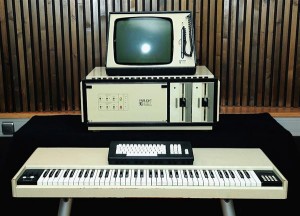Fairlight
Not many instruments has made as big an impact on shaping sound of an era as much as the Fairlight™ digital sampler. The first "Fairlight CMI Series I" was introduced in 1979 and was one of the first commercially available products to allow polyphonic playback of samples.
 The Fairlight™ CMI was designed by Peter Vogel and Kim Ryrie in Sydney, Australia. A complete Fairlight™ system constisted of a rack processing unit, a musical keyboard, a computer keyboard and a unique monochrome computer screen. The Fairlight™ had a menu driven graphical interface that could be controlled with a special light sensitive pen.
The Fairlight™ CMI was designed by Peter Vogel and Kim Ryrie in Sydney, Australia. A complete Fairlight™ system constisted of a rack processing unit, a musical keyboard, a computer keyboard and a unique monochrome computer screen. The Fairlight™ had a menu driven graphical interface that could be controlled with a special light sensitive pen.
With a retail price of around 25 000$, buying a Fairlight™ system was out of reach for most mortals but among the first buyers were established artists and producers like Peter Gabriel, Thomas Dolby, Kate Bush, and Richard James Burgess.
The original Fairlight™ could sample in 8-bit, 16 kHz, 8 voice polyphony and had a basic sequencer functionality. Later versions added increased the sample quality, polyphony, added support for MIDI (once it had been invented) and featured a more advanced sequencer known as "Page R".
The last generation of the Fairlight™ CMI, "Series III" was produced in 1985. If you have an iPad, check out Peter Vogel's "Fairlight Pro App" - a total recreation of a Fairlight™ system with support for the original CMI data files. The app let's you try the graphical interface that once revolutionized the music of the 80's.
Fairlight Moments
Famous uses include Herbie Hancock, Jan Hammer, Art Of Noise, Yello, Devo and Tears for Fears. See Wikipedia for a more extensive list of artists who used the Fairlight™.
Check out our Spotify playlist "Fairlight Moments" to listen to a collection of famous songs where the Fairlight™ played a prominent part.
About the Samples
The samples in our Fairlight™ collection were sampled from an overhauled System IIx (introduced in 1983) and the mapping is very detailed to capture the original sound character. A Fairlight™ instrument consisted of a single 16kb 8 bit sample that was mapped over the entire keyboard, but the voice cards performed some magic that pitched samples up and down in a much more pleasant way than if you were to do this with any generic hardware or software sampler, a very part of the Fairlight sound.
Disclaimer: Fairlight is a trademark of Fairlight.au Pty Ltd.
